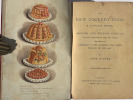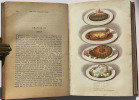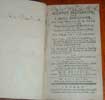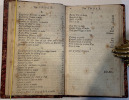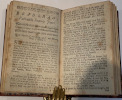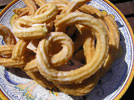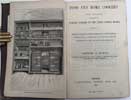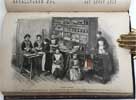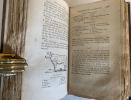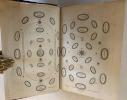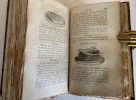Bradley.
Mrs Martha.
- Sole edition.
THE BRITISH HOUSEWIFE
Volume 1. - OR, THE COOK, HOUSEKEEPER’s AND GARDINER’S COMPANION. CALCULATED FOR THE Service both of London and the Country; And directing what is necessary to be done in the Providing for, Conducting, and Managing a Family throughout the Year, CONTAINING A general Account of fresh Provisions of all Kinds, Of the several Articles for the Table, pickled, or otherwise preserved; and the different Kinds of Spices, Salts, Sugars, and other Ingredients used in Pickling and Preserving at Home; Shew-ing what each is, whence it was bought, and what are its Qualities and Uses. Together with the Nature of all Kinds of Foods, and the Methos of suiting them to different CONSTITUTIONS; A Bill of Fare for each Month, the Art of Marketing and choosing fresh Provisions of all Kinds; and the making as well as chusing of Hams, Tongues, and other Store Dishes. Also Directions for plain Roasting and Boiling; and for the Dressing of all Sorts of Made Dishes in various Tastes; and the preparing the Desert in all its Articles. Containing a great Variety than was ever before publish’d, of the most Elegant, yet the least Expensive Receipts in COOKERY, PASRTRY, PUDDINGS, PRESERVES, PICKELS, FRICASSES,RAGOUTS, SOUPS, SAUCES, JELLIES, TARTS, CAKES, CREAMS, CUSTARDS, CANDIES, DRY’D FUITS, SWEETMEATS, MADE WINES, CORDIALS, and DISTILLARY. To which is annexed, The Art of Carving; and the Terms used for cutting up various Things; and the polite and easy Manner of doing the Honours of the Table: The Whole Prac-tice of Pickling and Preserving: And of preparing made Wines, Beer, Cyder.As also of distilling all the useful Kinds of Cordial and Simple Waters. With the Conduct of a Family in Respect of Health; the Disorders to which they are every Month liable, and the most approved Remedies for each. And a Variety of other valuable Particulars, necessary to known in All Families; and nothing inserted but what has been approved by EXERIENCE. Also the Ordering of all Kinds of profitable Beats and Fowls, With respect their Choice, their Breeding and Feeding; the Diseases to which they are severally laible each Month, and Receipts for their Cure. Together with the Management of the pleasant, profitable, and useful Garden. THE WHOLE Embellished with a great Number of curious COPPER PLATES, shewing the Manner of Trussing of all Kinds of Game, wild and tame Fowls, &c. as also the Order of setting out Tables for Dinners, Suppers, and Great Entertainments, in the Method never before attempted; and by which even those who cannot read will be able to instruct themselves. ( a line) Mrs MARTHA BRADLEY, late of BATH; Being the result of upwards of Thirty Years Experience. (a line) The whole (which is deduc’d form Practice) compleating the careful Reader, from the highest to the lowest Degree, in every Article of English Housewifery.
LONDON: Printed for S. Crowder and H. Woodgate, at the Golden Ball in Paternoster Row. Circa1756. -- Volume 2. - THE BRITISH HOUSEWIFE OR, THE COOK, HOUSEKEEPER’s AND GARDINER’S COMPANION. CALCULATED FOR THE Service both of London and the Country; And directing what is necessary to be done in the Providing for, Conducting, and Managing a Family throughout the Year, CONTAINING A general Account of fresh Provisions of all Kinds, Of the several Articles for the Table, pickled, or otherwise preserved; and the different Kinds of Spices, Salts, Sugars, and other Ingredients used in Pickling and Preserving at Home; Shew-ing what each is, whence it was bought, and what are its Qualities and Uses. Together with the Nature of all Kinds of Foods, and the Methods of suiting them to different CONSTITUTIONS; A Bill of Fare for each Month, the Art of Marketing and choosing fresh Provisions of all Kinds; and the making as well as chusing of Hams, Tongues, and other Store Dishes. Also Directions for plain Roasting and Boiling; and for the Dressing of all Sorts of Made Dishes in various Tastes; and the preparing the Desert in all its Articles. Containing a great Variety than was ever before publish’d, of the most Elegant, yet the least Expensive Receipts in COOKERY, PASRTRY, PUDDINGS, PRESERVES, PICKELS, FRICASSES,RAGOUTS, SOUPS, SAUCES, JELLIES, TARTS, CAKES, CREAMS, CUSTARDS, CANDIES, DRY’D FUITS, SWEETMEATS, MADE WINES, CORDIALS, and DISTILLARY. To which is annexed, The Art of Carving; and the Terms used for cutting up various Things; and the polite and easy Manner of doing the Honours of the Table: The Whole Prac-tice of Pickling and Preserving: And of preparing made Wines, Beer, Cyder.As also of distilling all the useful Kinds of Cordial and Simple Waters. With the Conduct of a Family in Respect of Health; the Disorders to which they are every Month liable, and the most approved Remedies for each. And a Variety of other valuable Particulars, necessary to known in All Families; and nothing inserted but what has been approved by EXERIENCE. Also the Ordering of all Kinds of profitable Beats and Fowls, With respect their Choice, their Breeding and Feeding; the Diseases to which they are severally laible each Month, and Receipts for their Cure. Together with the Management of the pleasant, profitable, and useful Garden. THE WHOLE Embellished with a great Number of curious COPPER PLATES, shewing the Manner of Trussing of all Kinds of Game, wild and tame Fowls, &c. as also the Order of setting out Tables for Dinners, Suppers, and Great Entertainments, in the Method never before attempted; and by which even those who cannot read will be able to instruct themselves. (a line) Mrs MARTHA BRADLEY, late of BATH; Being the result of upwards of Thirty Years Experience. (a line) VOL.II. (a line) The whole (which is deduc’d from Practice) compleating the careful Reader, from the highest to the lowest Degree, in every Article of English Housewifery.
LONDON: Printed for S. Crowder and H. Woodgate, at the Golden Ball in Paternoster Row. Circa1756.
FIRST and SOLE EDITION in book form. 8vo. Two volumes. Vol. I – 2feps. [1] Frontispiece of a kitchen declaring – Frontispiece of the Compleat English Cook. Title page. [1] 3-752. 5 Ornately engraved plates. 2 feps. -- Vol. II. 2 feps with ink inscription ‘M. Bache Wyken 1794.’ Title page. [1] 1-469. Contents to the First Volume (ix). Index for the First Volume (xii). Contents to the Second Volume (v). Index for the second volume (vii). 7 plates depicting settings for various dinners and a wedding and one for trussing. 2 feps. The five plates bound in Volume I are duplicated plus two others in Volume II. Both volumes in full original calf, slightly worn with nice patina and with repairs and neatly re-backed in the old style with raised bands and red morocco labels. Some wear and damp staining to both volumes, small amount of worming to bottom margin of Volume I and title page of Volume 11 cropped on the bottom but text still visible. Mainly the contents are clean and tight. A nice set. For a fuller account of the dating of this work see Gilly Lehmann's introduction to the facsimile edition published by Prospect Books, 1996, see also Cagle 401-2.
-
MacLean located an advertisement in ‘Scots Magazine’, January 1756 announcing the “British Housewife, No 1, To be continued weekly, 3d. Crowder.” While no copy has survived unbound in parts, part numbers 1-XLI are designated in the signatures. If the weekly schedule was maintained, publication would have been completed late in 1756. [Cagle p 402]
Martha Bradley’s directions and style is straightforward and factual. She writes well. She endeavours to help the cook and housewife better than had previously been attempted. There are no glossy photographs to beguile the reader, however there are handsome etched plates showing how to set a fine table.
Today, the abundance available to us all year round makes us forget the limits of that times and what the seasons allowed. For example, a winter table for twelve persons could have seven dishes placed on the table. February and March became the months when pickled and preserved foods provided the only variety. Then spring was the time to sow seasonal crops for future bounty. One of the etched plates shows an abundant table in July; the first course has seven plates laid out simultaneously and the second course another ten different dishes. An ostentatious display and one wonders what family and household’s position in society is the norm for a dinner like this.
Gastronomically, seasons do not affect us anymore. Today our menus can include anytime, a plethora of tropical fruits, fresh vegetables, fish and meats, flown in bi-weekly from all over the globe. As the title states, Bradley’s instructions for the running of the household from the marketing and providing of the kitchen month by month, the garden, the still-room, the brewery, the stables, the disorders of many types of animals and their remedies etc. It is clear that the author wrote the recipes from her experience in the kitchen and she is absolutely clear and firm that they should be carried out as laid down by her instructions. She is adamant that vegetables should not be over boiled, there are strict rules on the poaching of eggs: 'This is the true way ... our People all mistake it, they let the Eggs boil....
Although little is known about her other than she is believed to have been a professional cook,with 'thirty years experience' (as stated on her title page) Bradley favoured the newest French cooking style of the 1730’s which featured light, clean flavours, but was not above preferring a ‘plain’ English recipe if she felt it was better. She borrowed heavily from other cookbooks but always improved the recipes in some way, often providing insightful comments and offering balanced appraisals of the merits of one dish versus another. A very desirable set that stands out in any collection.






|
|

Antiquarian category
ref number:
11202
|

